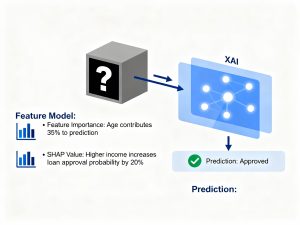
In the age of data overload, organizations are generating information at a staggering pace from customer transactions and web interactions to IoT sensors and supply chains. Yet, only a fraction of this data is ever turned into actionable insight. Traditional analytics tools often rely heavily on data scientists, manual dashboards, and human intuition limiting speed, scale, and accessibility.
Enter Augmented Analytics, the next evolution of business intelligence (BI). It combines Artificial Intelligence (AI), Machine Learning (ML), and Natural Language Processing (NLP) to automate data preparation, insight discovery, and sharing. Augmented Analytics empowers both technical and non-technical users to uncover hidden trends, make predictions, and generate narratives all with minimal human intervention.
Simply put, Augmented Analytics is “AI for analytics” it augments human decision-making by embedding intelligence into every step of the analytics process.
Key Components of Augmented Analytics
Augmented analytics ecosystems typically combine several technologies working together:
Data Preparation Automation
Cleans, enriches, and transforms raw data automatically using AI-based recommendations.
Example: Detecting missing values or data anomalies without manual scripts.
import pandas as pd
from sklearn.impute import SimpleImputer
data = pd.DataFrame({'Age': [25, None, 29, 35, None],
'Income': [45000, 54000, None, 62000, 58000]})
imputer = SimpleImputer(strategy='mean')
data[['Age', 'Income']] = imputer.fit_transform(data[['Age', 'Income']])
print(data)- This snippet demonstrates how automated imputation can “augment” data preparation.
- AI-Driven Insight Discovery: Machine learning models automatically surface correlations, trends, and anomalies that humans might miss.
- Natural Language Querying (NLQ): Users can type or speak queries like “Show me sales growth in Q3”, and the system generates results dynamically.
- Automated Data Visualization & Narratives: Charts, dashboards, and insights are auto-generated using AI — often with narrative summaries in plain English.
How Augmented Analytics Works
At its core, augmented analytics follows a multi-stage automated workflow:
- Data Ingestion
The system pulls structured or unstructured data from multiple sources (databases, APIs, CRMs, spreadsheets). - Data Cleaning & Enrichment
Algorithms detect errors, fill missing values, standardize units, and validate consistency. - Automated Model Selection
The AI engine evaluates multiple statistical and ML models to identify patterns — classification, regression, or clustering. - Insight Generation
Using ML and NLP, the platform automatically identifies relationships (e.g., “marketing spend drives 40% of revenue growth”). - Storytelling Layer
Augmented Analytics translates model outputs into human-readable stories.
Example: Automated Correlation Discovery in Python
import seaborn as sns
import pandas as pd
# Sample dataset
df = sns.load_dataset('tips')
correlations = df.corr(numeric_only=True)['tip'].sort_values(ascending=False)
print("Top Correlations with 'tip':\n", correlations)A simple example of automated insight extraction is a key concept in augmented analytics. Modern tools like Tableau GPT, Power BI Copilot, and ThoughtSpot Sage do this behind the scenes using AI.
Benefits of Augmented Analytics
- Democratization of Data
Non-technical users can explore data using natural language, reducing reliance on analysts. - Faster Decision-Making
Automated insights shorten the analytics cycle decisions from days to minutes. - Reduced Bias
AI models analyze data objectively, helping uncover patterns humans might overlook. - Cost Efficiency
Automation minimizes repetitive tasks like cleaning, joining, and visualizing data. - Scalability
Augmented analytics systems can handle massive data volumes from IoT and cloud systems effortlessly.
Example: Predictive Analytics in Augmented Systems
from sklearn.linear_model import LinearRegression
import numpy as np
X = np.array([[1], [2], [3], [4], [5]])
y = np.array([200, 400, 600, 800, 1000])
model = LinearRegression().fit(X, y)
prediction = model.predict([[6]])
print("Predicted value for 6th data point:", prediction[0])A simplified example of predictive analytics, a core component that powers augmented insights in business systems.
Use Cases and Applications
- Business Intelligence (BI):
Platforms like Power BI and Tableau now use AI assistants to auto-summarize data trends. - Finance & Banking:
AI-driven analytics detect fraud patterns, optimize risk models, and recommend investment actions. - Healthcare:
Augmented systems assist clinicians by highlighting anomalies in patient data or suggesting treatment outcomes. - Retail & Marketing:
Systems recommend pricing adjustments, product placements, and personalized campaigns. - Manufacturing & IoT:
Real-time machine data is analyzed automatically to predict breakdowns or optimize performance.
Augmented Analytics vs Traditional Analytics
Traditional analytics required manual SQL queries, static dashboards, and human interpretation. Augmented analytics adds automation + intelligence to every layer.
- Traditional Analytics: Reactive, relies on analysts, time-consuming.
- Augmented Analytics: Proactive, AI-driven, democratized.
For example:
- Traditional BI- “What were last month’s sales?”
- Augmented Analytics- “Sales dipped 8% last month due to reduced marketing spend in the East region.”
The difference lies in who does the thinking humans versus augmented AI systems.
Challenges and Considerations
Despite its advantages, augmented analytics introduces new challenges:
- Data Privacy & Governance
Automated data exploration must comply with regulations like GDPR and HIPAA. - Model Interpretability
As models become more complex, explaining why AI generated a specific insight can be difficult. - Bias in Algorithms
If source data is biased, AI-driven insights might reinforce those biases. - User Trust and Adoption
Business users may hesitate to rely on black-box AI recommendations. - Integration Complexity
Augmented systems must integrate smoothly with existing databases, BI tools, and APIs.
The Future of Augmented Analytics
The future points toward hyper-automation in decision-making, where AI systems not only generate insights but also act on them autonomously.
Key emerging trends include:
- Conversational Analytics — BI meets ChatGPT-style interactions: users chat with data.
- Predictive and Prescriptive Analytics — Systems will not only show what happened but also suggest what to do next.
- Integration with Cloud AI Platforms — AWS QuickSight Q, Google Looker, and Snowflake Cortex are embedding augmented intelligence natively.
- Explainable AI (XAI) — Transparency in augmented analytics models will improve trust.
- Edge Analytics — Real-time insights directly on IoT devices for industries like manufacturing and logistics.
Conclusion
Augmented Analytics represents a paradigm shift in how we approach data-driven decisions. It blends automation, intelligence, and accessibility, making analytics more human-friendly and business-focused. By embedding AI and ML throughout the analytics pipeline, organizations can scale insight generation, empower every employee with data fluency, and move from reactive reporting to proactive intelligence.
For developers, it opens exciting possibilities: integrating automated data pipelines, building NLP-based query engines, and creating explainable dashboards. For businesses, it means faster, smarter, and fairer decisions without waiting for an analyst to write a single SQL query.
In essence, Augmented Analytics doesn’t replace human intelligence, it amplifies it.
As AI systems become more transparent, personalized, and embedded into everyday tools, the boundary between human intuition and machine insight will continue to blur ushering in the true era of augmented decision-making.



